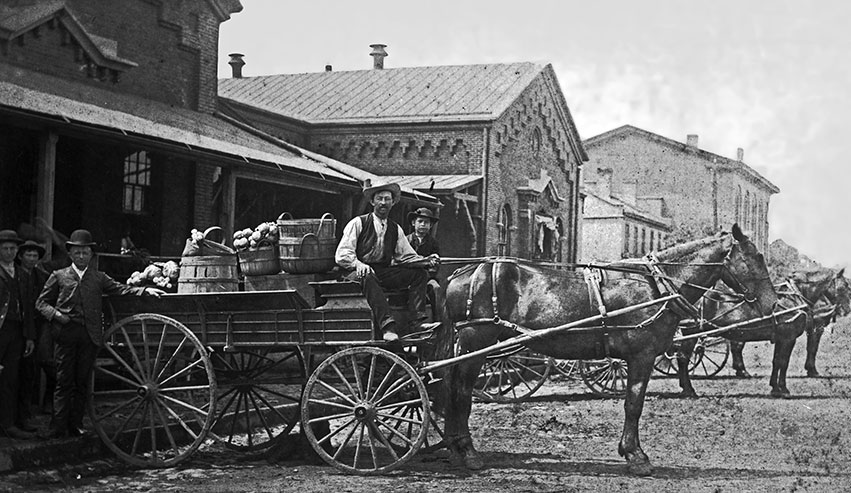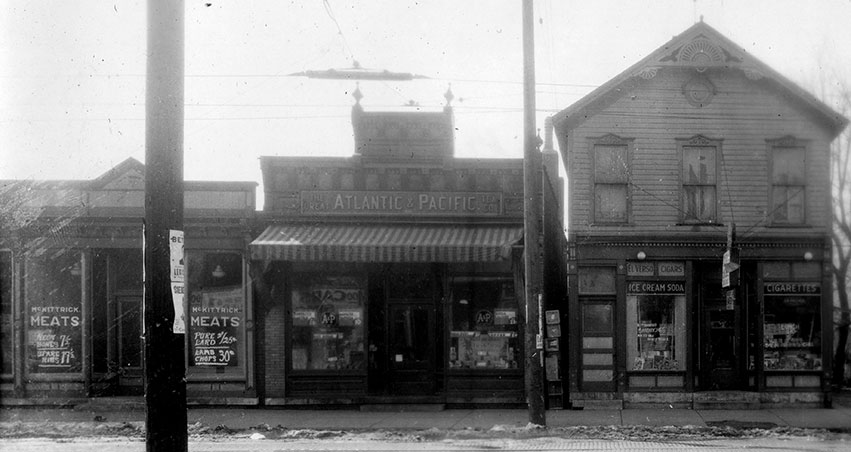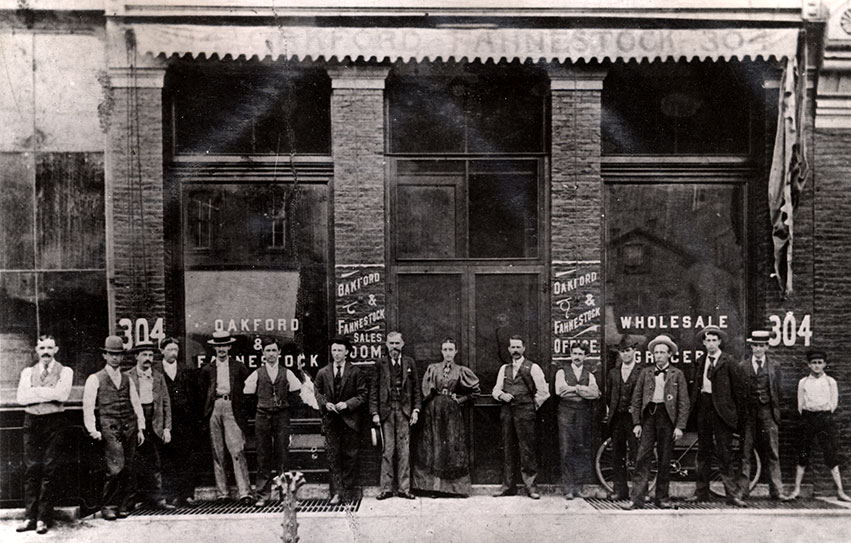From hundreds of family-owned shops to the handful of large chains today, the grocery business has never stood still.
Long gone are the days—as recently as the 1950s—when Peoria’s City Directory listed more than 300 area grocery stores. Most of them carried the name of the man (or, in some cases, the woman) who would be there to serve shoppers. In those days of densely compact neighborhoods and a single family car (if any), most people lived within a few blocks of at least one neighborhood grocery. Larger stores grew near the bus routes, until the days when parking needs demanded extra acreage.
The Early Grocery Trade
In its earliest days, downtown Peoria encompassed numerous grocery stores. The Powell Press building—Peoria’s oldest standing commercial building, relocated from Washington to Water Street in the late 1990s—once housed a grocery. Nearby meat markets and bakeries were common. Trefzger’s, still a very popular bakery today, got its start in 1861 on Fulton Street before relocating in 1870 to Main and Monroe, where it stood for 83 years!
Farmers’ markets were a seasonal draw, with Peoria’s riverfront a longtime focus. A city market opened in 1859 near City Hall—another place to get fresh vegetables, fruits and meats. The Peoria Market Gardeners and Fruit Growers organized in 1902. Dairies delivered milk to your home.

Peoria’s second marketplace, built in the late 1850s, was razed in 1897 to make way for the new Peoria City Hall.
The “mom and pop” stores generally involved the whole family: children, aunts, uncles and cousins. Some of today’s older adults remember heading to the stockyards with their grocer-dad to buy a side of beef to be butchered; others recall dusting the canned goods or keeping watch at the candy barrels as neighboring kids stopped in after school. Children learned to make change or record sales on a customer’s tab; big brothers got their driver’s license at 15 so they could deliver groceries after school.
In earlier times, it wasn’t unusual to be able to buy fresh ducks brought in by market hunters, venison traded to offset a bill, eggs from local chickens, and a large variety of locally-grown fruits and vegetables. While local farms still provide fresh turkeys at the holidays, getting a freshly-killed chicken happens only on the rare farm that still raises them.
Generations of Chains
Some local stores continued into the subsequent generations as well. Ben Schwartz built on a legacy that began with his grandfather Asher Schwartz’s store downtown. In 1933, Ben built a store on McClure Avenue, later adding stores on Sheridan at Glen and on North Prospect Road. In the early sixties, Ben Schwartz’s stores were regarded as the largest independent grocery stores in the state outside of Chicago. Known for carrying specialty and unusual foods, their kosher selection, and for being the first with an in-store liquor department, the stores continued for 66 years, into the next generation, before finally closing for good in 1999.

Three storefronts on the 600 block of West Main Street, including McKittrick Meats, A&P Grocery and Blossom’s Confectionary, with streetcar tracks running in front of the buildings
Various chains have come and gone through the years: Piggly Wiggly, Jewel Tea, A&P (originally Atlantic & Pacific Tea Company), SuperValu, Eagle and Cub Foods, as well as more local ones like Thompson’s Food Basket and Buehler’s. Newer chains—Aldi, Schnucks, Hy-Vee, The Fresh Market—have arisen to replace them. The small corner stores—including the plethora run by immigrants of various ethnic groups, whether German, Irish, Italian, Lebanese or Mexican—have all but disappeared. Haddad’s Market in West Peoria, founded in 1919 on Peoria’s East Bluff, arose from the ashes of a devastating fire several years ago, and continues to thrive.
In 1902, the Larkin Company, founded in 1875 in Buffalo, New York (where the original John Larkin lived), began developing Peoria as its largest branch and distribution center. The building at 401 Water Street and the one marked “Larkin” around the corner on Washington Street recall the days when that square block held not only the company’s warehouse and offices, but even a gas station. Yes, Larkin sold not just groceries, but also furniture, cleaning materials, perfume and gasoline. Larkin was sold in 1941 and liquidated in 1942, with some 65 of its stores bought by the Kroger Company.
Kroger, founded in 1883 by Barney Kroger of Cincinnati, came to Peoria in 1927 and ultimately absorbed many of the 20 Larkin stores in the Peoria area. Within the past year, Kroger has closed two of its stores here and suspended plans to enlarge their East Peoria store. But selling gas at grocery stores has become more common.

Oakford & Fahnestock, ca. 1895. The wholesale grocery company produced foods under the Blue Ribbon brand name. It was renamed the Oakford Company in 1939 and liquidated in 1958.
Ancillary Businesses & Services
Local grocery distributors also developed their own brands: Oakford & Fahnestock produced Blue Ribbon foods, while Chris Hoerr & Sons sold Re-Joyce and later Red Fox brands—names lost to consolidations. Peoria also had several canning factories, producing canned tomatoes and other vegetables. The pumpkin-canning operation in nearby Morton, now owned by Nestle, is still recognized as the largest producer in the country, while Princeville’s cannery, now part of Seneca Foods, also processes pumpkins.
When Peoria’s stockyards were booming, meat markets developed around it. Christian Buehler was one who took advantage of Peoria’s ice companies to refrigerate meats. Curing and smoking meats had previously been key to their preservation. Buehler and his sons subsequently became very wealthy, developing butcher shops and grocery stores in eight states from a Chicago base.
As head of the E. Godel & Sons meatpacking company near the stockyards, Christian Buehler, Jr. also benefited from the growth of his family’s far-flung meat and grocery businesses. Along with profitable real estate investments in Chicago, he amassed a significant fortune by the time of his 1921 death in Peoria. Prior to her own death five years later, his wife Phoebe created a trust for the creation of a home for the aged. The 1932 opening of the Christian Buehler Memorial Home for Aged People on Sheridan Road not only fulfilled her wish to honor her husband, but also their shared desire to help the elderly.
To this day, the Phoebe B. Buehler Trust uses the proceeds of the nearly $2 million fund to help underwrite the home. Their Springdale Cemetery mausoleum, termed the “finest in the west,” was completed following her death. The four Buehler stores here were all closed by 1966.
The Superstore Era
Today’s larger grocery stores now include pharmacies, floral departments and delis, and even a growing number of coffee shops and restaurants. On the other hand, a lengthy list of grocery items can now regularly be found in pharmacies, gas stations and department stores like Target and Walmart. Sam’s Club, Costco and GFS further add to the grocery alternatives available today, while Amazon’s purchase of Whole Foods is already adding a whole new dimension to grocery shopping. In these changing times, where do you stock up on foods? iBi
Check out "Market Days" on the PS Blog to see more historic photos of Peoria's older grocery stores courtesy of the Peoria Public Library Local History Collection.


